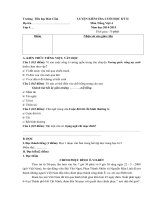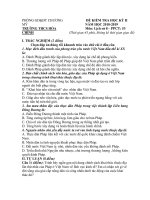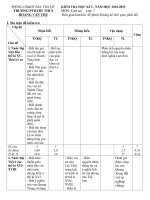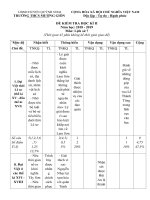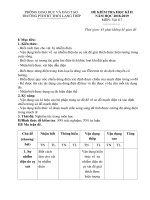Đề thi thử học kì 2 môn Tiếng Anh lớp 10 năm 2020 - 2021 THPT chuyên Bảo Lộc | Tiếng Anh, Lớp 10 - Ôn Luyện
Bạn đang xem bản rút gọn của tài liệu. Xem và tải ngay bản đầy đủ của tài liệu tại đây (122.14 KB, 5 trang )
<span class='text_page_counter'>(1)</span><div class='page_container' data-page=1>
SỞ GDĐT LÂM ĐỒNG
<b>TRƯỜNG THPT CHUYÊN BẢO LỘC</b>
<i>(Đề có 05 trang)</i>
<b>KIỂM TRA HỌC KÌ II NĂM HỌC 2019 – 2020</b>
<b>Mơn: TIẾNG ANH 10 (Chương trình Chun)</b>
<i>Thời gian làm bài: 60 phút (không kể thời gian phát đề)</i>
<b>Mã đề 139</b>
<b>Họ tên HS:…..…………..………Lớp: …………Số báo danh:……….Phòng thi: …….</b>
<b>ĐIỂM </b> <b>CHỮ KÍ GIÁM KHẢO </b> <b>SỐ PHÁCH </b>
<b>BẰNG SỐ</b> <b>BẰNG CHỮ </b> <b>GK 1 </b> <b>GK 2</b>
LISTENING
TASK 1. You will hear part of a talk about dolls. Complete the sentences with one word or a
<b>short phrase according to what you hear. </b> <b>(1.5 pts)</b>
The first known dolls were found in graves in 1. ____________.
The earliest dolls in the museum date from the 2. ____________.
Early European dolls were dressed like 3. ____________.
On the 17th<sub>-century dolls, you can see details like the 4. ____________.</sub>
17th<sub>-century dolls may cost as much as 5. ____________ each. </sub>
Collectors look for examples in perfect condition, with their 6. ____________.
19th<sub>-century dolls had 7. ____________ and real hair. </sub>
If you take off the doll’s hair, you may see the 8. ____________ underneath.
Before the 20th<sub> century, all dolls were 9. ____________, not babies. </sub>
From the 1930s, dolls were made of 10. ____________.
<i><b>Your answers: </b></i>
1. 2. 3. 4. 5.
6. 7. 8. 9. 10.
TASK 2. You will hear a woman talking about the developing science of Nanotechnology.
<b>Choose the best answer (A, B, or C) for each question below. </b> <b>(1.0 pt)</b>
1. In the field of transportation, Nanotechnology can help reduce the cost of ____________.
A. holiday insurance B. plane production C. space travel
2. With Nanotechnology, computers of the future will not only be faster but also have
______________ more memory.
</div>
<span class='text_page_counter'>(2)</span><div class='page_container' data-page=2>
3. Manufacturing with the use of Nano will _____________.
A. generate no waste B. replace oil consumption C. use all resources
4. Nanotechnology can also _____________.
A. eradicate famine B. produce feeding machines C. relieve the hungry feeling
5. In terms of healthcare, Nanotechnology can help _____________.
A. lengthen the aging process B. fulfill life expectations C. speed up medical tests
<i><b>Your answers: </b></i>
1. 2. 3. 4. 5.
LEXICO-GRAMMAR. Choose the best answer for each question below. <b>(3.0 pts) </b>
1. These are the students ___________ performances have been rewarded with scholarships.
A. that B. which C. whom D. whose
2. The local authority has decided to deny entry to the forest in an effort to ___________ its
pristine condition.
A. conserve B. preserve C. remain D. reserve
3. “Sorry. I’m late,” he said to his colleague.
A. He apologized to his colleague for being late.
B. He blamed his colleague for being late.
C. He felt sorry to his colleague for being late.
D. He said sorry to his colleague’s being late.
4. It is crucial that everyone ___________ present at the next meeting.
A. be B. will be C. were D. is
5. The new layers of vegetation can help slow down soil ____________ in the area.
A. depletion B. contamination C. erosion D. fertility
6. Serious attention ___________ to the possible negative impacts of tourism on the environment.
A. needs to pay B. is needed to be paid
C. needs to be paid D. is needed to pay
7. In an effort to reduce air pollution, many countries around the world have decided to
____________ the use of fossil fuels in production and transport.
A. heat up B. dry out C. phase out D. scale back
8. Loss of food supply and hunting coupled with pollution are putting whale species around the
world under ___________.
A. danger B. extinction C. risk D. threat
9. But for the doctors’ quick acts, this patient ___________ his life last week.
A. will lose B. would have lost C. would lose D. had lost
10. Development should be carried out in a way that is ___________ – we have to make sure
progress causes little or no harm to the overall wellbeing of the environment and its resources.
A. advantageous B. preservative C. sustainable D. technical
11. Cars running on petroleum can pollute the air because their engines ___________ harmful
gases.
</div>
<span class='text_page_counter'>(3)</span><div class='page_container' data-page=3>
<i><b>Your answers: </b></i>
1. 2. 3. 4. 5. 6.
7. 8. 9. 10. 11.
<b>Put each word in brackets in its correct form to complete these sentences. </b>
1. Tourists should be (<i><b>ecology</b></i>) ___________ sensitive so as to avoid spoiling the places they visit.
2. Viet Nam is a beautiful country with a (<i><b>diverse</b></i>) ___________ of traditions and customs.
3. The (<i><b>destroy</b></i>) ___________ impacts of deforestation are threatening the survival of wildlife in
various areas of the world.
4. A considerable majority of women are still suffering from (<i><b>equal</b></i>) ___________ in paid
employment round the world.
<i><b>Your answers: </b></i>
1. 2. 3. 4.
CLOZE READING. Choose the word/phrase (A, B, C, or D) that best fits each blank in the
<b>text.</b> <b>(1.0 pt)</b>
If you are an environmentalist, plastic is a word you tend to say with a sneer or a snarl. It has
become a symbol of our wasteful, throw-way society. But (1) _________ is little doubt that it is
here to stay, and the truth is, of course, that plastic has brought enormous (2) _________, even
environmental ones. It’s not really the plastics themselves that are the environmental evil – it’s the
way society choose to use and abuse them.
(3) _________ all the 50 or so different kinds of modern plastic are made from oil, gas or coal –
non-renewable natural resources. A high (4) _________ of our annual consumption is in the
(5)_________ of packaging, and this (6) _________ about seven percent by weight of our domestic
refuse, all of (7) _________ could be recycled. But very little of it is, though the plastic recycling
(8) _________ is growing fast.
The plastics themselves are extremely energy-rich – they have a higher calorific value than coal
and one method of “recovery” that is strongly (9) _________ by the plastic manufactures is the
conversion of waste plastic (10) _________ a fuel.
1. A. it B. there C. that D. what
2. A. pleasures B. benefits C. profits D. strengths
3. A. Almost B. Mostly C. Most D. Upmost
4. A. amount B. number C. proportion D. rate
5. A. form B. shape C. type D. way
6. A. builds up B. makes up C. puts up D. sets up
7. A. that B. them C. what D. which
8. A. career B. industry C. manufacture D. profession
9. A. agreed B. discussed C. needed D. preferred
10. A. in B. on C. to D. with
<i><b>Your answers: </b></i>
</div>
<span class='text_page_counter'>(4)</span><div class='page_container' data-page=4>
READING. Read this passage carefully then choose the best answer (A, B, C, or D) for each
<b>question below. </b> <b>(1.5 pts) </b>
In the exploration of linguistic life circle, it is apparent that it is much more difficult to learn a
second language in adulthood than a first language in childhood. Most adults never completely
master foreign language, especially in phonology – hence the ubiquitous foreign accent. Their
development often “fossilizes” into permanent error patterns that no teaching or correction can do.
Of course, there are great individual differences, which depend on effort, attitudes, amount of
exposure, quality of teaching and plain talent, but there seems to be a cap for the best adults in the
best circumstances.
Many explanations have been advanced for children’s superiority: they exploit Motherese (the
simplified, repetitive conversation between parents and children), make errors unselfconsciously,
are more motivated to communicate, like to conform, are not set in their ways, and have no first
language to interfere. But some of these accounts are unlikely, based on what is known about how
language acquisition works. Recent evidence is calling these social and motivation explanation into
doubt. Holding every other factor constant, a key factor stands out: sheer age.
Systematic evidence comes from the psychologist Elisa Newport and her colleagues. They
tested Korean and Chinese-born students at the University of Illinois who had spent at least ten
years in the United States. The immigrants were given a list of 276 simple English sentences, half
of them containing some grammatical errors. The immigrants who came to the United States
between the ages of 3 and 7 performed identically to American-born students. Those who arrived
between the ages of 8 and 15 did worse the later they arrived, and those who arrived between 17
and 39 did the worst of it, and showed huge variability unrelated to their age of arrival.
1. The passage is mainly about _____________
A. how adults are different from children in learning.
B. how language acquisition works among children.
C. how the age factor is related to language learning.
D. how research into language rules was done.
2. According to the first paragraph, what is TRUE about adults learning another language?
A. The majority of them have no trouble mastering it.
B. Their accent is similar to that of native speakers.
C. Their errors in language use are short-term.
D. Their learning is affected by a variety of factors.
3. According to the second paragraph, children learn language better than adults because of the
following reasons EXCEPT ____________
A. They repeat after their parents. B. They have had no languages.
C. They don’t love talking. D. They don’t have a fixed method.
4. The word “those” in the last paragraph refers to _____________.
A. Korean and Chinese-born students B. American-born students
C. different age groups D. English sentences
5. Which of the following is TRUE about the research mentioned in the passage?
A. The participants spoke English as their first language.
</div>
<span class='text_page_counter'>(5)</span><div class='page_container' data-page=5>
D. Most of the items in the test contained errors.
6. According to the passage, what was the purpose of the research?
A. To assess students’ language abilities.
B. To study the link between age and language ability.
C. To improve students’ relationship at school.
D. To collect data on students’ nationalities.
<i><b>Your answers: </b></i>
1. 2. 3. 4. 5. 6.
WRITING. Rewrite these sentences in such a way that their meaning is kept unchanged.
<b>(2.0 pts) </b>
1. It is time for us to stop activities that hurt wildlife.
→ It is high time we ………
2. His lack of confidence prevents him from getting promoted.
→ If ………
3. “Don’t get too close to the horse,” said the old man to the children.
→ The old man warned ………
4. The tour guide took us to a museum. We admired a lot of great relics there. (combine, use
<b>Relative clause) </b>
→ ………
5. “Where do you get the finance for the operation of the reserve?” the reporter asked the ranger.
→ The reporter asked ………..
6. We have to do something about the pollutants from local factories. (change into Passive)
→ Something ………
7. This is the most colorful festival we’ve ever observed.
→ None of ………
8. He missed the walking trip because he got sick at the last minute.
→ If ………
</div>
<!--links-->


